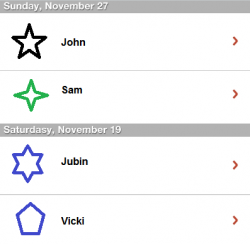I have JSON like below
{
createdDate = "Sunday, November 27";
imageURL = "www.abc.com/john.png";
imageName = "John"
},
{
createdDate = "Sunday, November 27";
imageURL = "www.abc.com/sam.png";
imageName = "Sam"
},
{
createdDate = "Saturday, November 19";
imageURL = "www.abc.com/jubin.png";
imageName = "Jubin"
},
{
createdDate = "Saturday, November 19";
imageURL = "www.abc.com/vicki.png";
imageName = "Vicki"
},
I have to display this data in Table View Grouped by date ie date 27 has 2 items and similar date 19 has another 2 items, how can I achieve this using NSArray and NSDictionary or any other data structure.
Please see the attached image for your reference.
My Table View understanding is
1) First we need to count no of sections
2) Then no rows in each sections
3) Then we can set height for section if required
4) also setting the header for each section
5) rendering cell for each row in a section
But I was not able to show this JSON data in table view. Any hint or idea would be appreciable.
{
createdDate = "Sunday, November 27";
imageURL = "www.abc.com/john.png";
imageName = "John"
},
{
createdDate = "Sunday, November 27";
imageURL = "www.abc.com/sam.png";
imageName = "Sam"
},
{
createdDate = "Saturday, November 19";
imageURL = "www.abc.com/jubin.png";
imageName = "Jubin"
},
{
createdDate = "Saturday, November 19";
imageURL = "www.abc.com/vicki.png";
imageName = "Vicki"
},
I have to display this data in Table View Grouped by date ie date 27 has 2 items and similar date 19 has another 2 items, how can I achieve this using NSArray and NSDictionary or any other data structure.
Please see the attached image for your reference.
My Table View understanding is
1) First we need to count no of sections
2) Then no rows in each sections
3) Then we can set height for section if required
4) also setting the header for each section
5) rendering cell for each row in a section
But I was not able to show this JSON data in table view. Any hint or idea would be appreciable.


